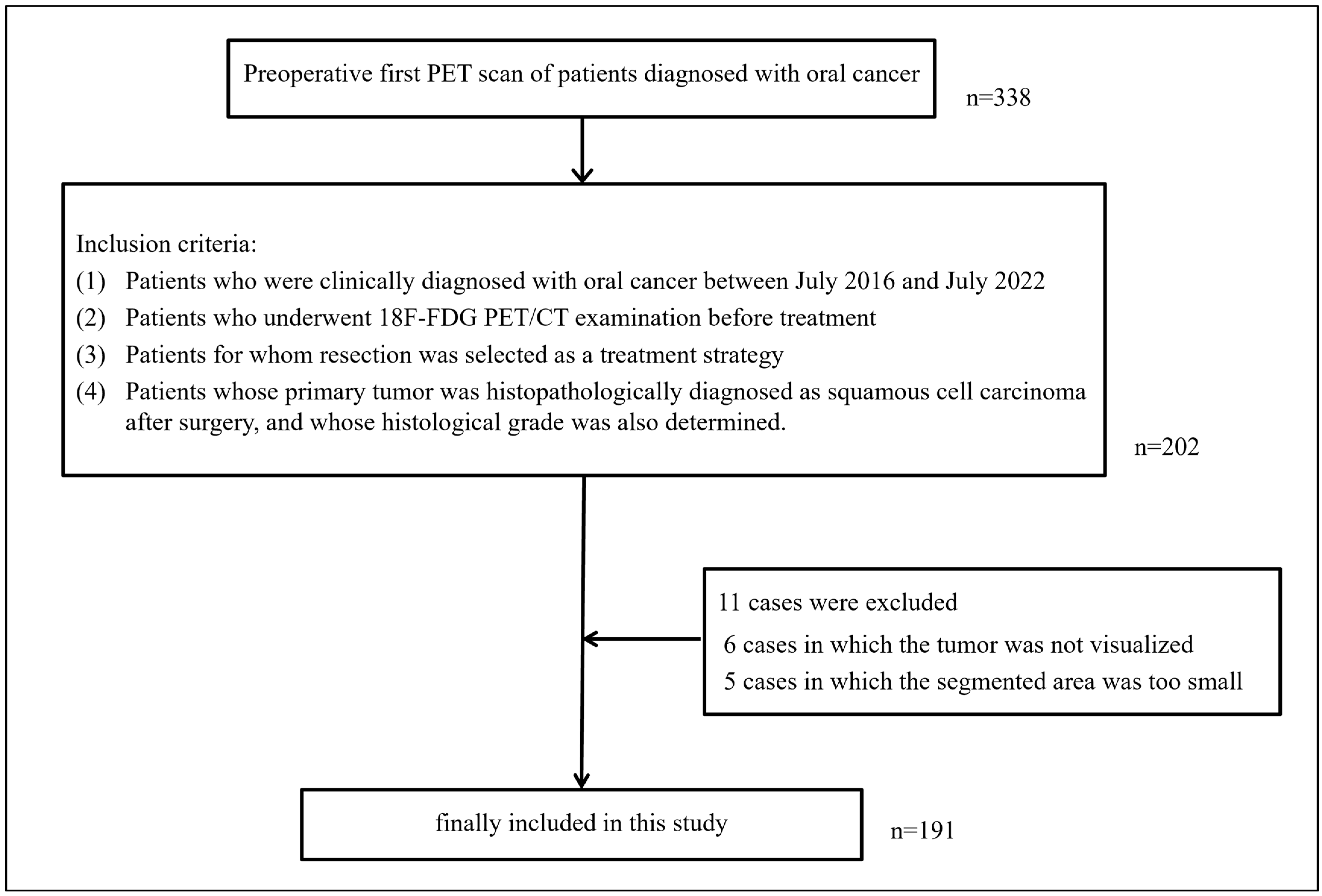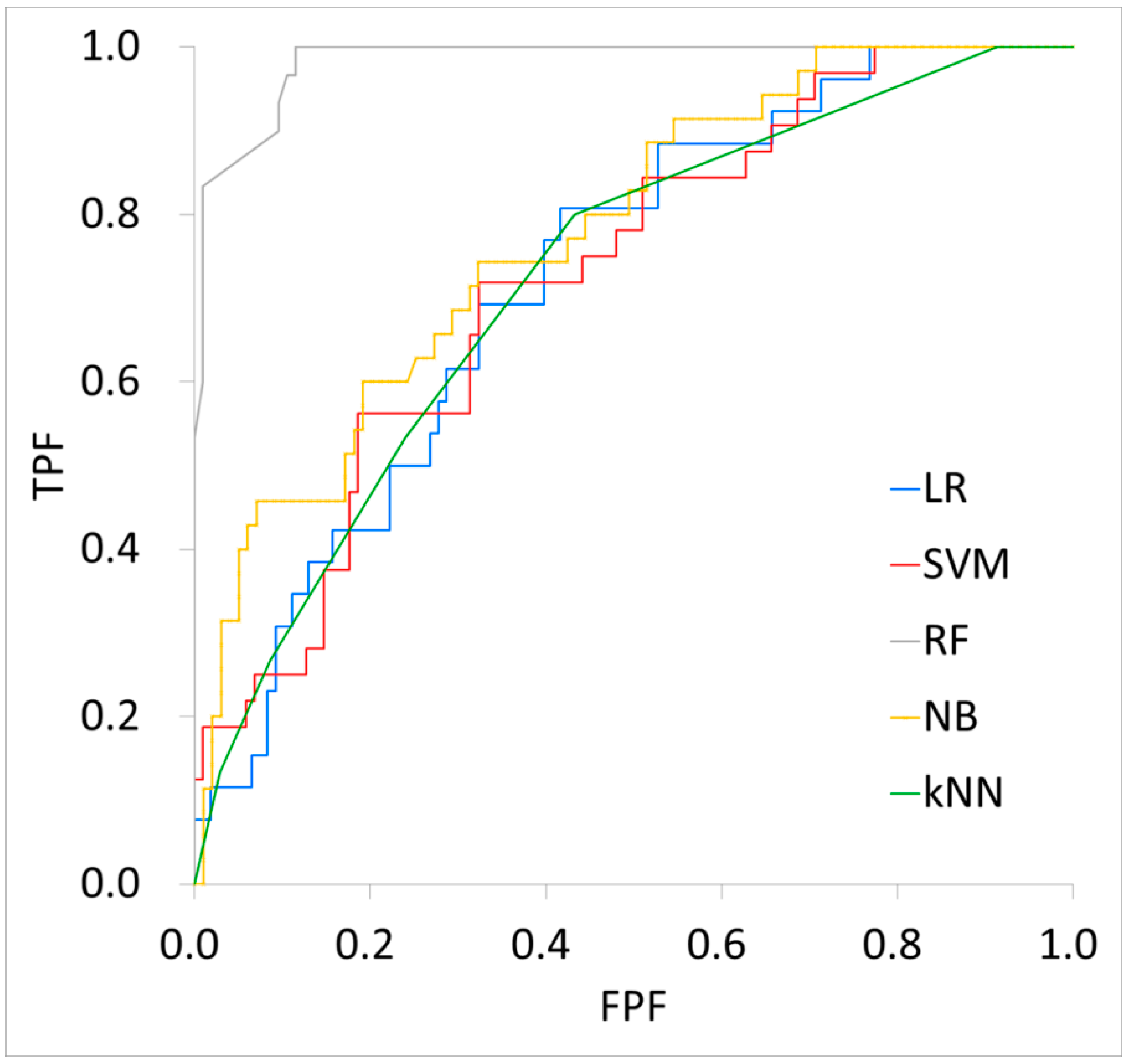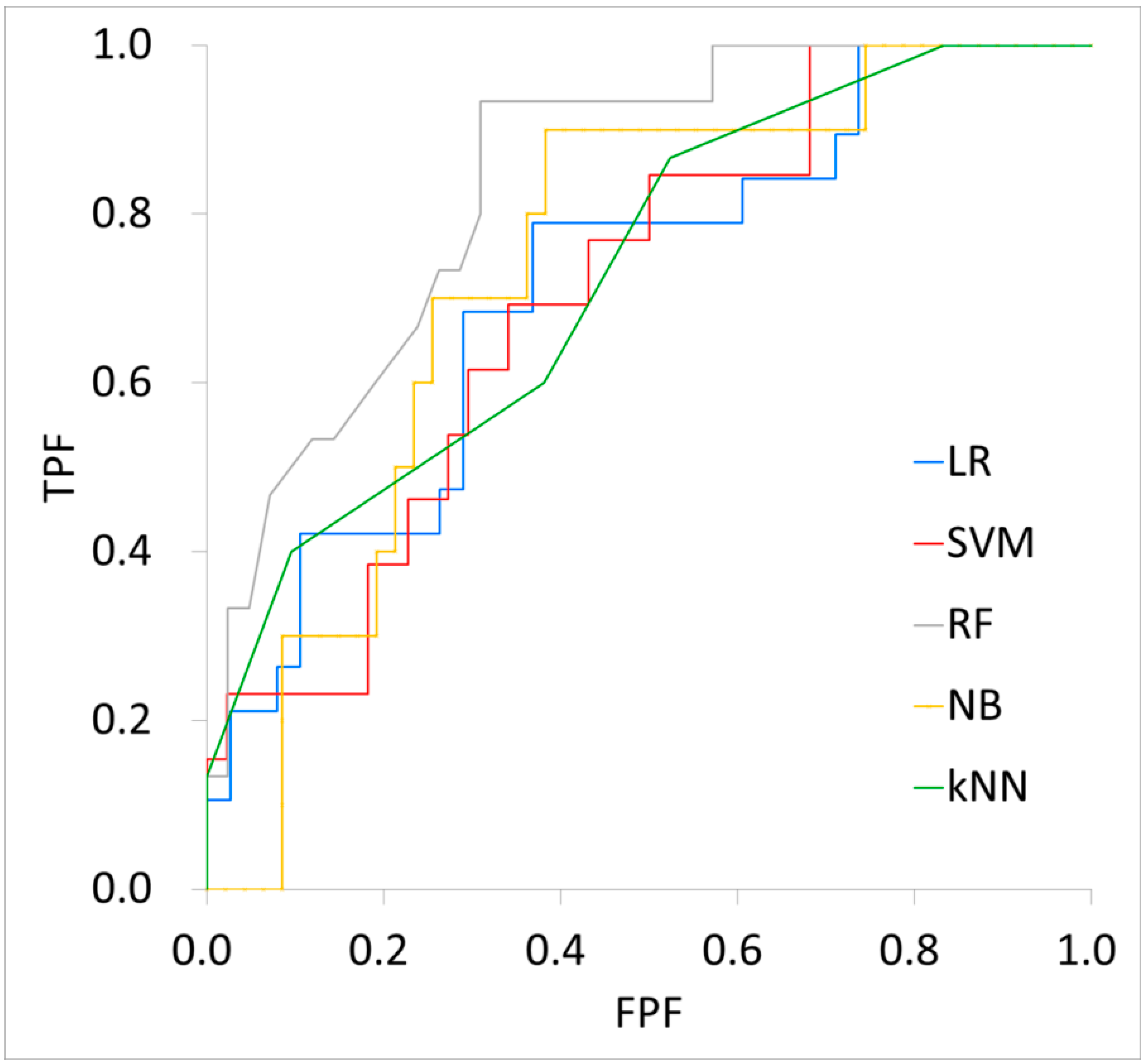Prediction of Histological Grade of Oral Squamous Cell Carcinoma Using Machine Learning Models Applied to 18F-FDG-PET Radiomics
Abstract
:1. Introduction
2. Materials and Methods
2.1. Ethical Approval
2.2. Subjects
2.3. Image Acquisition
2.4. Radiomics Analysis
2.4.1. Segmentation of Lesions
2.4.2. Extraction of Radiomics Features from Each Segmented Lesion
2.4.3. Verification of the Radiomics Features Useful for Predicting the Histological Grade of Oral Squamous Cell Carcinoma
2.4.4. Radiomics Feature Selection for Creating Machine Learning Prediction Models
2.4.5. An Evaluation of the Accuracy of the Machine Learning Models’ Predictions of Oral Squamous Cell Carcinoma Histological Grade
3. Results
4. Discussion
5. Conclusions
Author Contributions
Funding
Institutional Review Board Statement
Informed Consent Statement
Data Availability Statement
Conflicts of Interest
References
- World Cancer Research Fund International. Mouth and Oral Cancer Statistics. Available online: https://www.wcrf.org/cancer-trends/mouth-and-oral-cancer-statistics/ (accessed on 24 April 2024).
- Ikeda, M.; Suzuki, M.; Matsuzuka, T.; Ishii, S.; Sato, H.; Murono, S. Neoadjuvant Superselective Intra-Arterial Cisplatin Chemoradiotherapy Combined with Surgery in Patients with T4 Squamous Cell Carcinoma of the Maxillary Sinus. J. Oral Maxillofac. Surg. 2022, 80, 1445–1450. [Google Scholar] [CrossRef] [PubMed]
- Cariati, P.; Rico, A.M.S.; Ferrari, L.; Ozan, D.P.; Corcóles, C.G.; Rodriguez, S.A.; Ferrari, S.; Lara, I.M. Impact of histological tumor grade on the behavior and prognosis of squamous cell carcinoma of the oral cavity. J. Stomatol. Oral Maxillofac. Surg. 2022, 123, e808–e813. [Google Scholar] [CrossRef]
- Ferrari, L.; Cariati, P.; Zubiate, I.; Rico, A.M.S.; Rodriguez, S.A.; Encinas, R.M.P.; Ferrari, S.; Lara, I.M. Controversies in the treatment of early-stage oral squamous cell carcinoma. Curr. Probl. Cancer 2024, 48, 101056. [Google Scholar] [CrossRef] [PubMed]
- Hosni, A.; Huang, S.H.; Chiu, K.; Xu, W.; Su, J.; Lu, L.; Bayley, A.; Bratman, S.V.; Cho, J.; Giuliani, M.; et al. Validation of distant metastases risk-groups in oral cavity squamous cell carcinoma patients treated with postoperative intensity-modulated radiotherapy. Radiother. Oncol. 2019, 134, 10–16. [Google Scholar] [CrossRef]
- Oyama, T.; Hosokawa, Y.; Abe, K.; Hasegawa, K.; Fukui, R.; Aoki, M.; Kobayashi, W. Prognostic value of quantitative FDG-PET in the prediction of survival and local recurrence for patients with advanced oral cancer treated with superselective intra-arterial chemoradiotherapy. Oncol. Lett. 2020, 19, 3775–3780. [Google Scholar] [CrossRef]
- Duvernay, J.; Schlund, M.; Majoufre, C. Contribution of FDG-PET in the diagnostic assessment of cervical lymph node metastasis in Oral Cavity Squamous Cell Carcinoma (OCSCC). J. Stomatol. Oral Maxillofac. Surg. 2023, 124, 101659. [Google Scholar] [CrossRef]
- Yamakawa, N.; Nakayama, Y.; Ueda, N.; Yagyuu, T.; Tamaki, S.; Kirita, T. Volume-based 18F-fluorodeoxyglucose positron emission tomography/computed tomography parameters correlate with delayed neck metastasis in clinical early-stage oral squamous cell carcinoma. Oral Radiol. 2023, 39, 668–682. [Google Scholar] [CrossRef] [PubMed]
- Shimizu, T.; Kim, M.; Palangka, C.R.A.P.; Seki-Soda, M.; Ogawa, M.; Takayama, Y.; Yokoo, S. Determination of diagnostic and predictive parameters for vertical mandibular invasion in patients with lower gingival squamous cell carcinoma: A retrospective study. Medicine 2022, 101, e32206. [Google Scholar] [CrossRef] [PubMed]
- Ryu, I.S.; Kim, J.S.; Roh, J.L.; Cho, K.J.; Choi, S.H.; Nam, S.Y.; Kim, S.Y. Prognostic significance of preoperative metabolic tumour volume and total lesion glycolysis measured by (18)F-FDG PET/CT in squamous cell carcinoma of the oral cavity. Eur. J. Nucl. Med. Mol. Imaging 2014, 41, 452–461. [Google Scholar]
- Kumar, V.; Gu, Y.; Basu, S.; Berglund, A.; Eschrich, S.A.; Schabath, M.B.; Forster, K.; Aerts, H.J.W.L.; Dekker, A.; Fenstermacher, D.; et al. Radiomics: The process and the challenges. Magn. Reson. Imaging 2012, 30, 1234–1248. [Google Scholar] [CrossRef]
- Gillies, R.J.; Kinahan, P.E.; Hricak, H. Radiomics: Images Are More than Pictures, They Are Data. Radiology 2016, 278, 563–577. [Google Scholar] [CrossRef] [PubMed]
- Bur, A.M.; Holcomb, A.; Goodwin, S.; Woodroof, J.; Karadaghy, O.; Shnayder, Y.; Kakarala, K.; Brant, J.; Shew, M. Machine learning to predict occult nodal metastasis in early oral squamous cell carcinoma. Oral Oncol. 2019, 92, 20–25. [Google Scholar] [CrossRef] [PubMed]
- Li, H.M.; Gong, J.; Li, R.M.; Xiao, Z.B.; Qiang, J.W.; Peng, W.J.; Gu, Y.J. Development of MRI-Based Radiomics Model to Predict the Risk of Recurrence in Patients with Advanced High-Grade Serous Ovarian Carcinoma. AJR Am. J. Roentgenol. 2021, 217, 664–675. [Google Scholar] [CrossRef] [PubMed]
- Kubo, K.; Kawahara, D.; Murakami, Y.; Takeuchi, Y.; Katsuta, T.; Imano, N.; Nishibuchi, I.; Saito, A.; Konishi, M.; Kakimoto, N.; et al. Development of a radiomics and machine learning model for predicting occult cervical lymph node metastasis in patients with tongue cancer. Oral Surg. Oral Med. Oral Pathol. Oral Radiol. 2022, 134, 93–101. [Google Scholar] [CrossRef]
- Toyama, Y.; Hotta, M.; Motoi, F.; Takanami, K.; Minamimoto, R.; Takase, K. Prognostic value of FDG-PET radiomics with machine learning in pancreatic cancer. Sci. Rep. 2020, 10, 17024. [Google Scholar] [CrossRef]
- Nikkuni, Y.; Nishiyama, H.; Hyayashi, T. Histogram analysis of 18F-FDG PET imaging standardized uptake values may predict the histological grade of oral squamous cell carcinoma. Oral Surg. Oral Med. Oral Pathol. Oral Radiol. 2022, 134, 254–261. [Google Scholar] [CrossRef] [PubMed]
- Evrimler, S.; Gedik, M.A.; Serel, T.A.; Ertunc, O.; Ozturk, S.A.; Soyupek, S. Bladder Urothelial Carcinoma: Machine Learning-based Computed Tomography Radiomics for Prediction of Histological Variant. Acad. Radiol. 2022, 29, 1682–1689. [Google Scholar] [CrossRef]
- Wang, H.; Chen, H.; Duan, S.; Hao, D.; Liu, J. Radiomics and Machine Learning with Multiparametric Preoperative MRI May Accurately Predict the Histopathological Grades of Soft Tissue Sarcomas. J. Magn. Reson. Imaging 2020, 51, 791–797. [Google Scholar] [CrossRef] [PubMed]
- Park, J.H.; Quang, L.T.; Yoon, W.; Baek, B.H.; Park, I.; Kim, S.K. Predicting Histologic Grade of Meningiomas Using a Combined Model of Radiomic and Clinical Imaging Features from Preoperative MRI. Biomedicines 2023, 11, 3268. [Google Scholar] [CrossRef]
- Ren, J.; Qi, M.; Yuan, Y.; Tao, X. Radiomics of apparent diffusion coefficient maps to predict histologic grade in squamous cell carcinoma of the oral tongue and floor of mouth: A preliminary study. Acta Radiol. 2021, 62, 453–461. [Google Scholar] [CrossRef]
- Li, Z.; Liu, Z.; Guo, Y.; Wang, S.; Qu, X.; Li, Y.; Pan, Y.; Zhang, L.; Su, D.; Yang, Q.; et al. Dual-energy CT-based radiomics nomogram in predicting histological differentiation of head and neck squamous carcinoma: A multicenter study. Neuroradiology 2022, 64, 361–369. [Google Scholar] [CrossRef] [PubMed]
- Zheng, Y.M.; Che, J.Y.; Yuan, M.G.; Wu, Z.J.; Pang, J.; Zhou, R.Z.; Li, X.L.; Dong, C. A CT-Based Deep Learning Radiomics Nomogram to Predict Histological Grades of Head and Neck Squamous Cell Carcinoma. Acad. Radiol. 2023, 30, 1591–1599. [Google Scholar] [CrossRef]
- Abenavoli, E.M.; Barbetti, M.; Linguanti, F.; Mungai, F.; Nassi, L.; Puccini, B.; Romano, I.; Sordi, B.; Santi, R.; Passeri, A.; et al. Characterization of Mediastinal Bulky Lymphomas with FDG-PET-Based Radiomics and Machine Learning Techniques. Cancers 2023, 15, 1931. [Google Scholar] [CrossRef]
- Wang, F.; Tan, R.; Feng, K.; Hu, J.; Zhuang, Z.; Wang, C.; Hou, J.; Liu, X. Magnetic Resonance Imaging-Based Radiomics Features Associated with Depth of Invasion Predicted Lymph Node Metastasis and Prognosis in Tongue Cancer. J. Magn. Reson. Imaging 2022, 56, 196–209. [Google Scholar] [CrossRef] [PubMed]
- Konishi, M.; Kakimoto, N. Radiomics analysis of intraoral ultrasound images for prediction of late cervical lymph node metastasis in patients with tongue cancer. Head Neck 2023, 45, 2619–2626. [Google Scholar] [CrossRef]
- Cheng, J.; Ren, C.; Liu, G.; Shui, R.; Zhang, Y.; Li, J.; Shao, Z. Development of High-Resolution Dedicated PET-Based Radiomics Machine Learning Model to Predict Axillary Lymph Node Status in Early-Stage Breast Cancer. Cancers 2022, 14, 950. [Google Scholar] [CrossRef]
- Orlhac, F.; Thézé, B.; Soussan, M.; Boisgard, R.; Buvat, I. Multiscale Texture Analysis: From 18F-FDG PET Images to Histologic Images. J. Nucl. Med. 2016, 57, 1823–1828. [Google Scholar] [CrossRef]




| Characteristics | Number |
|---|---|
| Age | |
| Average | 68.9 |
| Range | 23–91 |
| Sex | |
| Male | 113 |
| Female | 78 |
| Site of primary tumor | |
| Tongue | 97 |
| Floor of oral mouth | 10 |
| Gingiva of maxilla | 22 |
| Gingiva of mandible | 38 |
| Buccal mucosa | 22 |
| Palate | 1 |
| Lip | 1 |
| pT classification | |
| T1 | 69 |
| T2 | 65 |
| T3 | 12 |
| T4a | 42 |
| T4b | 3 |
| Histological grade | |
| Well differentiated | 146 |
| Moderately/poorly differentiated | 45 |
| Feature |
|---|
| bins0.1 original NGTDM Contrast |
| bins2 original GLSZM Zone Percentage |
| bins0.01 WL_HHH Histogram Mean |
| bins0.03 WL_HHH GLSZM Small Area High Gray Level Emphasis |
| bins0.05 WL_HHH GLDM Small Dependence High Gray Level Emphasis |
| bins0.05 WL_HHH GLSZM High Gray Level Zone Emphasis |
| bins0.05 WL_HHH GLSZM Small Area High Gray Level Emphasis |
| bins0.05 WL_HHH GLSZM Small Area Low Gray Level Emphasis |
| bins0.05 WL_HHH GLCM Cluster Shade |
| bins0.1 WL_HHH GLCM Cluster Shade |
| bins0.1 WL_HHH GLCM Difference Average |
| bins0.1 WL_HHH GLDM Small Dependence High Gray Level Emphasis |
| bins0.1 WL_HHH GLRLM Short Run High Gray Level Emphasis |
| bins0.1 WL_HHH GLRLM Gray Level Variance |
| bins0.2 WL_HHH GLCM Difference Average |
| bins0.2 WL_HHH GLCM Sum Squares |
| bins0.2 WL_HHH GLCM Contrast |
| bins0.2 WL_HHH GLCM Cluster Shade |
| bins0.2 WL_HHH GLCM Cluster Tendency |
| bins0.2 WL_HHH GLRLM Gray Level Variance |
| bins0.3 WL_HHH GLCM Contrast |
| bins0.3 WL_HHH GLCM Sum Squares |
| bins0.3 WL_HHH GLDM Gray Level Variance |
| bins0.3 WL_HHH GLRLM Gray Level Variance |
| bins0.3 WL_HHH GLSZM Gray Level Variance |
| bins0.5 WL_HHH GLCM Sum Average |
| bins0.5 WL_HHH GLCM Idmn |
| bins0.5 WL_HHH GLDM High Gray Level Emphasis |
| bins0.5 WL_HHH GLDM Low Gray Level Emphasis |
| bins0.5 WL_HHH GLRLM Short Run High Gray Level Emphasis |
| bins0.5 WL_HHH GLRLM Low Gray Level Run Emphasis |
| bins0.5 WL_HHH GLRLM High Gray Level Run Emphasis |
| bins0.5 WL_HHH NGTDM Complexity |
| bins5 WL_HHH GLRLM Short Run High Gray Level Emphasis |
| bins0.1 WL_LLL GLDM Dependence Non-Uniformity Normalized |
| bins5 WL_LLL GLSZM Zone Percentage |
| bins5 WL_LLL GLSZM Small Area High Gray Level Emphasis |
| bins10 WL_LLL GLSZM Small Area High Gray Level Emphasis |
| bins10 WL_LLL NGTDM Strength |
| Number of features |
| Bins |
| 0.01–0.05 7 features |
| 0.1–0.5 26 features |
| 1–5 4 features |
| 10 2 features |
| Image |
| Original image 2 features |
| Wavelet HHH image 32 features |
| Wavelet LLL image 5 features |
| Feature type |
| Shape feature 0 features |
| First order feature 1 features |
| Texture feature 38 features |
| Matrix of texture feature |
| GLCM 12 features |
| GLDM 6 features |
| GLRLM 8 features |
| GLSZM 9 features |
| NGTDM 3 features |
| Feature | Coefficient |
|---|---|
| bins0.01 WL_HHH Histogram Mean | −0.00596191 |
| bins0.05 WL_HHH GLSZM Small Area Low Gray Level Emphasis | −0.00429615 |
| bins5 WL_HHH GLRLM Short Run High Gray Level Emphasis | −0.00345513 |
| bins10 WL_LLL GLSZM Small Area High Gray Level Emphasis | −0.00285311 |
| bins0.5 WL_HHH GLRLM Short Run High Gray Level Emphasis | −0.00199623 |
| bins0.5 WL_HHH GLCM Idmn | −0.0019436 |
| bins0.5 WL_HHH NGTDM Complexity | −0.00122783 |
| bins0.05 WL_HHH GLCM Cluster Shade | −0.000958007 |
| bins0.1 WL_LLL GLDM Dependence Non-Uniformity Normalized | 0.0300688 |
| I Title 1 | ML Model | AUC | Accuracy (%) | Sensitivity (%) | Specificity (%) | PPV (%) | NPV (%) |
|---|---|---|---|---|---|---|---|
| Training cohort (n = 134) | LR | 0.72 | 81 | 12 | 98 | 60 | 82 |
| SVM | 0.73 | 76 | 13 | 100 | 100 | 78 | |
| RF | 0.98 | 94 | 77 | 99 | 96 | 94 | |
| NB | 0.78 | 74 | 51 | 82 | 50 | 83 | |
| kNN | 0.72 | 78 | 0 | 100 | 0 | 78 | |
| Testing cohort (n = 57) | LR | 0.72 | 67 | 11 | 100 | 100 | 100 |
| SVM | 0.71 | 77 | 15 | 98 | 67 | 80 | |
| RF | 0.84 | 79 | 53 | 88 | 62 | 84 | |
| NB | 0.74 | 72 | 70 | 72 | 35 | 92 | |
| kNN | 0.73 | 74 | 13 | 100 | 100 | 76 |
Disclaimer/Publisher’s Note: The statements, opinions and data contained in all publications are solely those of the individual author(s) and contributor(s) and not of MDPI and/or the editor(s). MDPI and/or the editor(s) disclaim responsibility for any injury to people or property resulting from any ideas, methods, instructions or products referred to in the content. |
© 2024 by the authors. Licensee MDPI, Basel, Switzerland. This article is an open access article distributed under the terms and conditions of the Creative Commons Attribution (CC BY) license (https://creativecommons.org/licenses/by/4.0/).
Share and Cite
Nikkuni, Y.; Nishiyama, H.; Hayashi, T. Prediction of Histological Grade of Oral Squamous Cell Carcinoma Using Machine Learning Models Applied to 18F-FDG-PET Radiomics. Biomedicines 2024, 12, 1411. https://doi.org/10.3390/biomedicines12071411
Nikkuni Y, Nishiyama H, Hayashi T. Prediction of Histological Grade of Oral Squamous Cell Carcinoma Using Machine Learning Models Applied to 18F-FDG-PET Radiomics. Biomedicines. 2024; 12(7):1411. https://doi.org/10.3390/biomedicines12071411
Chicago/Turabian StyleNikkuni, Yutaka, Hideyoshi Nishiyama, and Takafumi Hayashi. 2024. "Prediction of Histological Grade of Oral Squamous Cell Carcinoma Using Machine Learning Models Applied to 18F-FDG-PET Radiomics" Biomedicines 12, no. 7: 1411. https://doi.org/10.3390/biomedicines12071411
APA StyleNikkuni, Y., Nishiyama, H., & Hayashi, T. (2024). Prediction of Histological Grade of Oral Squamous Cell Carcinoma Using Machine Learning Models Applied to 18F-FDG-PET Radiomics. Biomedicines, 12(7), 1411. https://doi.org/10.3390/biomedicines12071411






